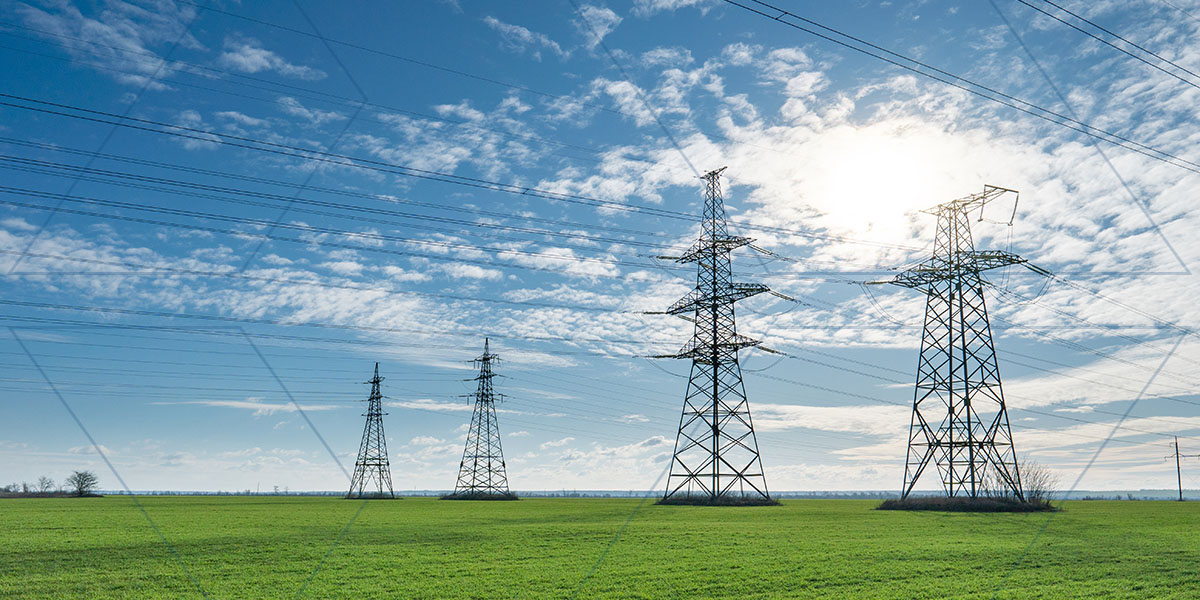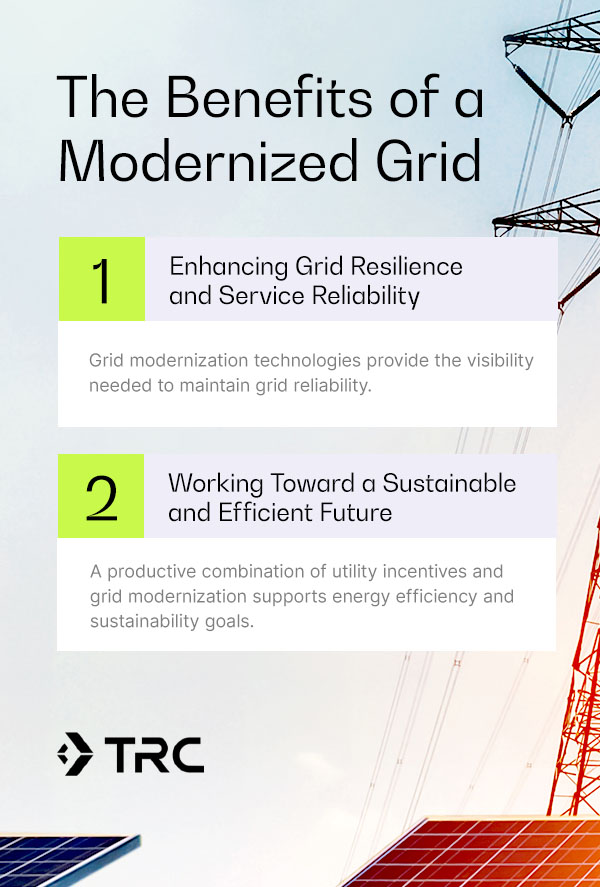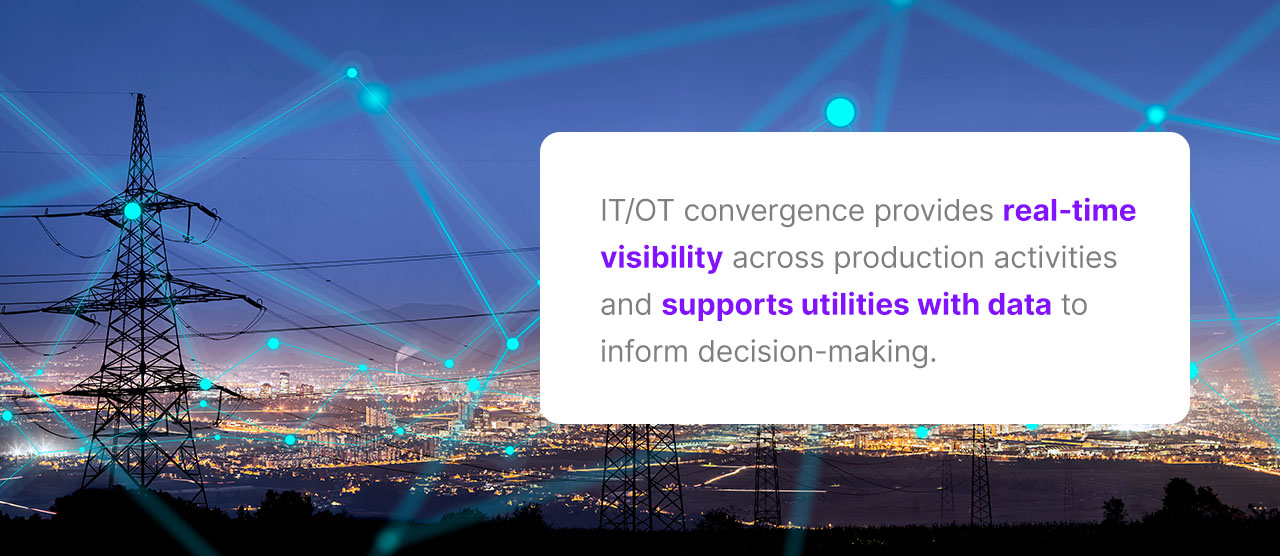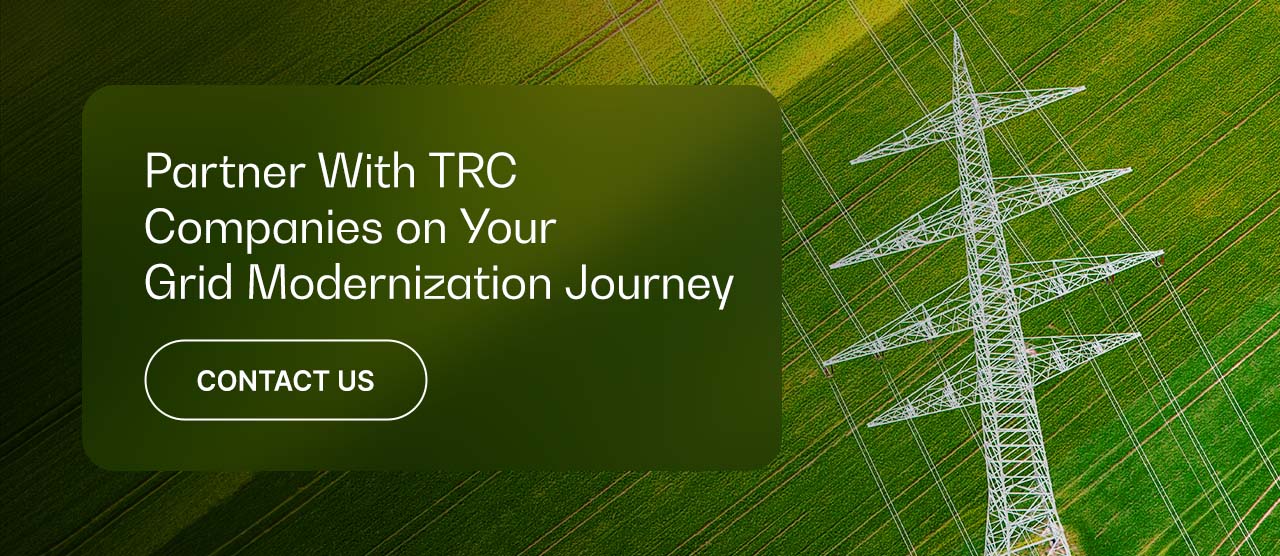Over 70% of the power grid is more than 25 years old, and much has changed in the last quarter of a century. From increasing demands on existing infrastructure to a renewed focus on moving away from fossil fuels, the grid must achieve unprecedented goals. However, today’s grid cannot meet growing energy needs or complex challenges brought on by a shift to renewable energy sources.
A modern grid design is the only way to reinvigorate existing infrastructure and assets to cope with challenges ranging from climate anomalies to cybercrime. Grid modernization blends advanced technologies with a sustainable strategy to make the electric grid more reliable, resilient, secure and affordable.
An Introduction to Grid Modernization
In simple terms, electric grid modernization is the process of upgrading the grid and integrating new technology to make it more efficient and resilient. It requires several significant changes, including incorporating new energy generation and storage forms, installing smart technologies and upgrading or extending the existing infrastructure.
Today’s electric grid is one of the most complex machines in the world. Yet, objectives have evolved in the face of climate change. Grid modernization paves the way for a complete energy transition — eliminating reliance on fossil fuels to produce energy. The power industry has changed considerably, from generation to transmission and distribution. An effective grid modernization strategy allows the grid to keep up with these changes.
Increasingly complex energy challenges combined with the grid’s age make providing consistent and continuous energy more challenging. In short, the current grid alone cannot support the energy transition. More consumers are turning to renewable energy sources and distributed energy resources (DERs) to ensure a reliable, separate power source. Integrating these advancements into the existing grid can make it capable of supporting and maintaining a complete energy transition.
Power Grid Modernization and Its Critical Importance
Power outages have become more frequent across the United States as the grid struggles to cope with evolving power requirements and increasingly severe weather events. Modernizing the grid to align with smart technology makes it more reliable and resilient. Blending the latest technologies and equipment with digital controls that integrate and communicate can significantly reduce the frequency and duration of power outages and the impact of inclement weather. In addition, grid modernization supports faster service return when outages occur.
Smart grid technology also gives consumers easy access to their energy data, empowering them to manage their consumption and costs. The process also benefits utilities, and 60% of leaders and investors in the energy sector identify the need to monitor, control and protect grid conditions as a primary driver for global grid modernization. It provides improved security and load management, lowers costs and facilitates the integration of renewables.
Many existing grid modernization projects are already meeting 21st-century energy needs. In the U.S., the modern grid will incorporate innovative technologies like microgrids and smart grid technologies to boost grid flexibility and agility, meeting today’s needs.
Renewable energy sources could provide 90% of the reductions in carbon dioxide (CO2) emissions. In line with global net-zero goals, integrating renewables like wind, solar and hydrogen power into the grid is a top priority. Grid modernization aims to address many of today’s energy challenges, optimize grid operations, enhance reliability and support frictionless integration of renewable technologies.
The Crucial Role of Technology in Grid Transformation
Digital transformation profoundly impacts the energy sector, providing benefits like improved efficiency, cost reduction and elevated consumer experience. Implementing grid modernization technology is the only way to boost grid reliability, resiliency and power quality.
Several groundbreaking technologies have emerged as many utilities, organizations and communities collaborate around grid modernization.
Leveraging Smart Grid Technologies
The smart grid is the heart of the grid modernization effort. It enables real-time monitoring through advanced sensing, communications and control capabilities, optimizing the energy system to meet modern demands. Instead of the one-way flow of communication in the traditional grid, the smart grid leverages digital technology that allows for two-way communication between consumers and utilities.
Smart meters, distribution automation and intelligent grid management systems empower utilities to monitor energy consumption. They can detect faults in real time and manage demand. When all the smart grid elements work together, it ultimately results in improved reliability and resilience in times of crisis.
Integrating Renewable Energy Sources
Renewable energy sources are an integral part of the modern grid. Solar photovoltaics, wind turbines, hydrogen power and hydropower systems have experienced massive growth as industries aim to minimize emissions. Innovative technology allows the integration of renewable technologies and smart grids, offering abundant clean energy alternatives alongside efficient energy management, distribution and consumption.
Climate variability and weather unpredictability are significant challenges in transitioning to renewables. The energy demand is inconsistent, and people use energy in peaks and valleys. Grid modernization facilitates the transition to renewables, counteracting source variability with innovations like advanced forecasting and demand response programs. These technologies reduce greenhouse gas emissions in the energy sector while enhancing grid flexibility and reliability.
Incorporating Energy Storage Systems
Energy storage systems like DERs remove much unpredictability in renewable energy integration. DERs integration, including small-scale clean energy installations like photovoltaic panels and energy storage, enhances energy efficiency and resilience while supporting the decarbonization of the energy sector. DER technology can transform energy systems, decentralizing the energy market and reducing pressure on the grid. While often provided as standalone solutions, the value of DERs compounds when integrated into smart grids.
Modernization includes adapting the grid to integrate and optimize power from DERs. Once integrated, DERs need extensive monitoring and control via an advanced distribution management system to detect and mitigate faults before they become outages. Distributed energy resource management systems can solve many modern grid resiliency challenges.
Modernizing With the Cloud
Grid modernization requires complete visibility. A modern grid requires transparent communication across all components. The cloud is critical in achieving grid modernization objectives, including resilience, flexibility and affordability. Cloud services and solutions are designed to provide extreme redundancy and availability while optimizing cost and performance.
Agility is another critical grid modernization goal. The grid must meet growing customer demands, maintain compliance with evolving regulations and respond to unforeseen events. The cloud can facilitate rapid system positioning and help utilities stay agile despite shifting operating conditions.
Related Services
 The Benefits of a Modernized Grid
The Benefits of a Modernized Grid
Although the grid modernization concept arose from a pressing need to reinvigorate outdated infrastructure, it provides general benefits to utilities, organizations and consumers, including:
Enhancing Grid Resilience and Service Reliability
Grid modernization technologies provide the visibility needed to maintain grid reliability. For example, smart meters can help utilities manage electricity demand, capturing more data than manual readings. Data analytics advancements also enable organizations to monitor grid assets remotely. The technology sends real-time alerts when grid components need repairs and maintenance, allowing organizations to address minor issues before they become big problems.
The need for enhanced resilience and grid security in the face of natural disasters, physical attacks and cyber threats is clear. Grid modernization incorporates technologies like microgrids, self-healing grids and advanced monitoring that isolate and restore power during unforeseen events.
A modern grid also incorporates robust physical and cybersecurity infrastructure to safeguard the grid against malicious actors. Grid modernization ensures energy supply continuity by supporting security and resilience while strengthening the overall energy infrastructure.
Working Toward a Sustainable and Efficient Future
A productive combination of utility incentives and grid modernization supports energy efficiency and sustainability goals. In the transition to renewable energy, a modern grid is necessary to integrate intermittent energy sources into the grid efficiently.
A modern grid supports advanced forecasting, energy storage systems and demand response programs. It manages renewables effectively, accelerating the journey to complete energy transmission. Wherever renewables are generated, the modern grid can connect them, routing power where needed to provide a consistent supply.
Facing the Challenges of Grid Modernization
Grid modernization is a considerable undertaking, and utilities face many hurdles as they embark on this journey. The modernized grid must accomplish several objectives, including withstanding outages, maintaining energy quality, remaining resilient in severe weather events, boosting energy efficiency and resisting physical and cyber attacks. At the same time, it must remain economically viable for utilities, businesses and consumers.
Connecting renewables to the grid is complex, and combatting energy variability requires an advanced management system to avoid grid imbalance. Energy transmission is another common challenge. Distribution across long distances requires modern infrastructure to limit energy losses in the form of heat.
Further, only 31% of Americans are willing to cut out the use of fossil fuels altogether. Many objections to renewables involve their proximity to where people live. Public opposition is a significant challenge, whether the objections center around aesthetics, safety or misinformation.
Strategies for Grid Modernization Projects
Despite the challenges, modernization programs are poised to meet resiliency, efficiency and renewable energy integration objectives.
The energy sector is fluid. Grid capabilities will likely change and grow. Utilities must set themselves up for long-term growth by starting on foundational investments, like smart grid monitoring and control. Investments in energy storage technology like DERs also position the grid for success, providing solutions for many variability and transmission challenges.
A convergence of information and operations technologies, or IT/OT, is essential for grid modernization. It provides real-time visibility across production activities and supports utilities with data to inform decision-making. Integrated IoT sensors across the modern grid provide real-time infrastructural updates, allowing teams to perform timely and consistent maintenance.
Breaking down data silos and making data accessible across the network is crucial to tackling grid modernization challenges. Utilities need a unified view of the entire system, from generation to distribution, requiring a free flow of data across the utility and any other stakeholders in the energy ecosystem.
Automation is another valuable tool in managing the increased complexity of a sustainable, modernized grid. A modernized energy grid is fed by data collected from millions of data points. Effective automation and integrations allow these data sources to deliver an improved grid view, allowing for better decision-making and enhanced grid resilience.
The Path Toward an Advanced Grid
The electrical grid is becoming more distributed, which will likely continue into the future. However, today’s interconnected grid began as a series of distributed grids, joined over time to improve reliability, safety and cost efficiency. Technological advancements will continue to pave the way for grid modernization and efficiency.
Users will demand more reliability from the grid in the future, including resilience during significant weather or security events. Alongside these evolving demands and changing technological advancements, the global energy transition remains one of the most compelling objectives of this century. Grid modernization represents a mindset shift alongside the changing infrastructure.
Grid modernization innovations have shaped the energy sector, paving the way for a transition to a more sustainable and energy-efficient future. Embracing smart grid technologies, integrating renewable energy sources and leveraging technology to boost grid resilience provides an opportunity to build an energy ecosystem capable of handling the demands of the future.
The Essential Work of Grid Modernization
Modernizing the power grid means upgrading physical infrastructure, from distribution systems to transmission lines and substations. It also means integrating advanced smart grid technologies, including sensors, smart meters, and communication devices, to monitor the grid’s performance and intervene in times of crisis.
Grid modernization technologies enable a two-way flow of electricity and information between utilities and consumers, empowering communities to participate in their own consumption. Building a modern grid requires a collaborative and holistic approach, incorporating strategies from the public and private sectors. While it may be a technical challenge, grid modernization could be the most impactful move to mitigate climate change and secure the future for generations to come.
Partner With TRC Companies on Your Grid Modernization Journey
As we modernize our power grid, we can expect widespread change across the energy sector. Environmental pressures, regulatory requirements and rapid technological advancements will continue to transform the industry, alongside complex business issues and infrastructural investments. Keeping up to date with these changes is essential, and working with experts with their fingers on the pulse of energy transformations can revolutionize your organization.
TRC can help you navigate each step in your grid modernization journey, lending you our expertise to plan and implement your strategy. As a trusted partner to the utility industry for over half a century, we have the resources and experience to determine the most effective roadmap for each organization’s unique needs. Contact us to learn how we can solve your current and future modernization challenges today.



 The Benefits of a Modernized Grid
The Benefits of a Modernized Grid
